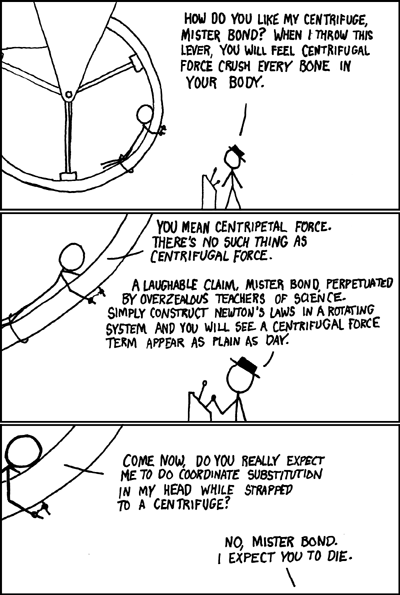Bramblethorn
Sleep-deprived
- Joined
- Feb 16, 2012
- Posts
- 17,399
This is where English etymology meets physics pedantry: that "centrifuge" function actually depends on what many physicists would call a centripetal force.Without going into the Greek roots ("fugein" being "to flee", as opposed to "peitein" being "to seek", if I remember correctly from a lifetime ago), the easy way to remember is this: when you open your washing machine, you'll find that your clothes are pressed against the outside - and that's because washing machines have a centrifuge function.
If you whirl a yo-yo around your head, the string will always be under tension: it's constantly pulling the yo-yo towards you (the central point). In a standard physics analysis, to keep the yo-yo orbiting in a circle, it has to be constantly accelerating towards the centre, which requires a centre-seeking force. If I let go of the string - cancelling that force - the yo-yo would fly away from me, not towards me.
The laundry in a spinning washing machine isn't actually experiencing a force pushing it away from the centre; rather, it's moving, and that movement if unchecked would carry it away from the centre - if it stopped interacting with the wall, it would keep moving in a straight line at a constant speed and go right through the wall and out of the machine.
But since it's solid, it can't phase through the wall like that. Effectively, it's continually colliding with the wall of the machine - a glancing collision - and that collision is pushing it back towards the middle, keeping it in orbit.
That's the Physics 101 version, where the room is still and the machine is spinning, and this is why some physicists will smugly tell you that there ain't no such thing as "centrifugal": it's all centripetal.
But in Physics 102, we might find it convenient to pretend that the machine is still (its innards, that is) and the rest of the world is spinning. In that frame of reference then we do take care of the rotation by imagining a force that pushes things away from the centre. We actually do this a lot - for instance, I would describe myself as "sitting still" right now even though the Earth is rotating and I'm rotating with it - so the Physics 102 framework is more aligned with an intuitive understanding of the situation.
(And in a sense, all forces are imagined; they're not something we can directly observe, just a conceptual convenience for explaining how they behave.)
TLDR the insistence on "centripetal" over "centrifugal" comes from people who know enough physics to be pedantic about it, but not enough physics to understand that sometimes there's more than one way to describe a system, and there's one important framework where "centrifugal" is valid.
